

Trusted News Since 1995
A service for global professionals · Thursday, May 2, 2019 · 484,049,649 Articles · 3+ Million Readers
Latest News from the Malawi Diaspora


Trusted News Since 1995
A service for global professionals · Thursday, May 2, 2019 · 484,049,649 Articles · 3+ Million Readers
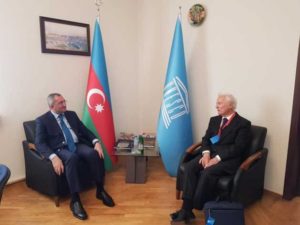
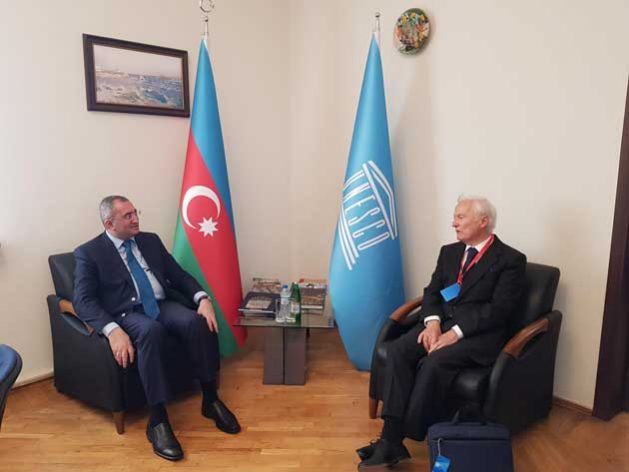
– In relation to the participation of the Geneva Centre at the Fifth World Forum on Intercultural Dialogue, the Executive Director of the Geneva Centre Ambassador Idriss Jazairy participated in several high-level meetings in Azerbaijan.
The aim of these meetings was to enhance the Centre’s collaboration with civil society organizations and national human rights commissions in Azerbaijan in the field of interfaith dialogue and the promotion of mutual understanding and cooperative relations between societies in the Global North and the Global South.
In the meeting with the Executive Secretary of the National Commission for UNESCO, Ambassador Elnur Sultanov, Ambassador Jazairy informed the latter about the outcome of the 25 June 2018 World Conference on religions and equal citizenship rights.
Ambassador Jazairy mentioned that the World Conference was inspired by the endeavours of the President of the Republic of Azerbaijan HE Ilham Aliyev to initiatie the Baku Process that aims to enhance mutual understanding and respect between individuals and groups with different ethnic, cultural, religious and linguistic backgrounds.
The World Conference – they said – had been a timely opportunity to promote intercultural and inter-faith dialogue among international experts, opinion makers, religious, lay and government leaders in times when religion has been considered as a source of division.
In light of this discussion, the participants highlighted the need to capitalize on the momentum of the World Conference and to examine inventive ways to carry the process forward to harness the collective energy of religions, creeds and value systems in the pursuit of equal citizenship rights.
The participants agreed that with the rise of populism in advanced societies and violent extremism in the MENA region, the promotion of religious tolerance and peaceful cooperation between world societies is needed more than ever. In this connection, Ambassador Sultanov cited the Constitution of UNESCO which says: “since wars begin in the minds of men, it is in the minds of men that the defences of peace must be constructed.”
In this connection, both parties agreed to pursue joint activities to enhance inter-faith dialogue and inter-cultural understanding through the holding of conferences at the United Nations Office in Geneva and in Azerbaijan. Ambassador Sultanov and Ambassador Jazairy likewise expressed their readiness to conduct joint research studies on religious tolerance and multiculturalism in Europe.
Addressing the surge of Islamophobia in Europe
In a second meeting held in Baku, Ambassador Jazairy was welcomed by the Chairman of the State Committee on Religious Associations Mr Mubariz Gurbanli. Ambassador Jazairy used the opportunity to inform Mr Gurbanli about the endeavours of the Centre to promote and enhance the protection of human rights in the Arab region.
Both parties agreed that the rise of Islamophobia has given rise to anti-Muslim and anti-Arab sentiments in advanced societies in the West. Mr Gurbanli highlighted that the State Committee on Religious Associations had organized several high-level inter-faith meetings, similar to that of the 25 June World Conference, in Finland, Germany and Sweden between religious leaders of Islam, Christianity and Judaism.
The outcome of these meetings, Mr Gurbanli, highlighted, had enabled religious bodies of these faiths to come together so as to build understanding and harmony as well as to address issues related to Islamophobia, Christianophobia and anti-Semitism that prevail in societies whether in Europe or in the Middle East.
In this relation, Ambassador Jazairy used the opportunity to present the 10-point World Conference Outcome Declaration on “Moving Towards Greater Spiritual Convergence Worldwide in Support of Equal Citizenship Rights” and the latter’s follow-up actions.
The said declaration, Ambassador Jazairy, appeals to decision makers to harness the collective energy of religions, creeds and value systems in the pursuit of equal citizenship rights. The Geneva Centre’s Executive Director mentioned that there is 90% convergence between faiths and 10% specificity. In the current context, media and decision makers tend to focus on the 10% that divides societies which have given rise to a toxic narrative about the other.
To reverse this ominous trend, Ambassador Jazairy mentioned the importance of promoting equal citizenship rights so as to avoid that social segments of society fall back on sub-identities to achieve their human rights. The Geneva Centre’s Executive Director also noted that secularity includes diversity while secularism works to exclude faith-based groups.
In light of this discussion, both parties agreed to organize joint conferences on inter-faith dialogue in the future and to conduct further research on points of commonalities of religions, creeds and value systems in the pursuit of joint values. Mr Gurbanli used the occasion to invite Ambassador Jazairy to participate in a major inter-religious forum in Vienna in June this year.
Signing of MoU with the International Eurasia Press Fund
In the presence of national MPs of the Parliament of Azerbaijan, members of national human rights commissions, diplomatic community, civil society organizations and media representatives, the Geneva Centre signed an MoU with the International Eurasia Press Fund.
The MoU lays the foundation for a collaborative partnership between both organizations in the holding of joint panel debates at the United Nations Office in Geneva on issues related to global governance, the promotion of human rights of IDPs as well as the promotion of cooperative relations between people and societies.
The agreement also commits the parties to arrange and organize joint training programmes in relation to the promotion of human rights, peace and sustainable development in the Middle East and North Africa (MENA) region as well as in Azerbaijan.
During the meeting, the President of the International Eurasia Press Fund Mr Umud Mirzayev expressed his appreciation for the endeavours of the Centre to promote a value driven human rights system.
The Charge d’Affaires at the Embassy of the Swiss Confederation in Azerbaijan Ms Simone Haeberli likewise praised the endeavours of the Centre to promote inter-cultural understanding around the world and stated that she was proud that Switzerland had hosted the 25 June World Conference on religions and equal citizenship rights.
Ambassador Jazairy thanked Mr Mirzayev and Ms Haeberli for the hospitality expressed to the Centre during the signing ceremony and extended his appreciation to the MPs of the Parliament of Azerbaijan that attended the signing ceremony and expressed their support to the work of the Centre.
Italian Islamic Religious Community to cooperate with the Geneva Centre to promote inter-religious understanding
During a meeting with the Chairman of the Italian Islamic Religious Community Mr Yahya Pallavicini, and the Executive Director of the Geneva Centre, the parties expressed their commitment to pursue joint activities to promote inter-religious understanding in Europe between faith leaders and religious followers at grassroot level.
Mr Pallavicini mentioned he had taken note of the outcome of the World Conference and its Outcome Declaration and used the opportunity to invite Ambassador Jazairy to present the ten-point declaration during a public hearing at the Italian Parliament.
The Geneva Centre’s Executive Director accepted this proposal and expressed his readiness to meet with the President of the Italian Islamic Religious Community. Both parties agreed to sign a partnership agreement to formalize their cooperation in the near future.
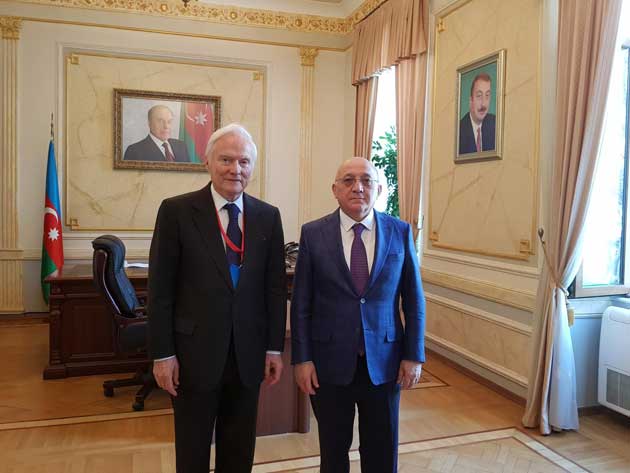
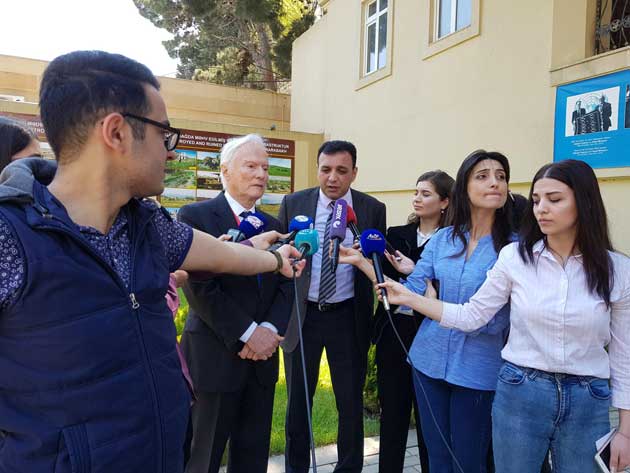
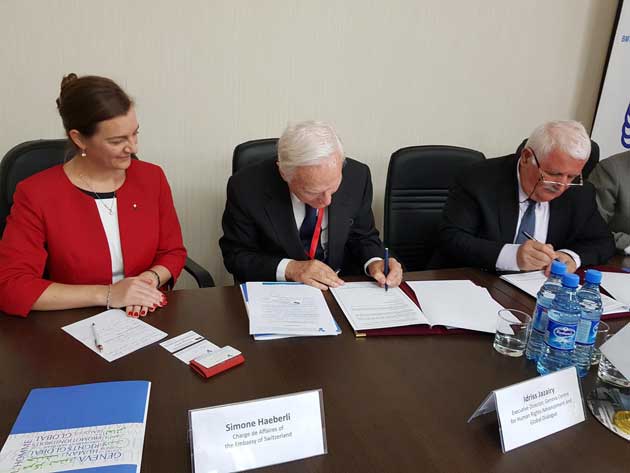
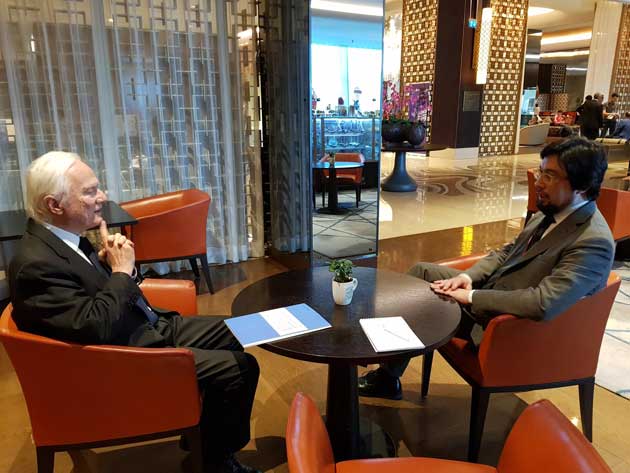
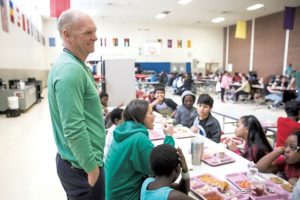
A student talent show brought parents, grandparents, sisters and brothers to the Winooski schools auditorium on a Friday night at the end of March. The toddlers among them cavorted happily below the stage, creating an impromptu program of their own — even after a red velvet curtain opened to reveal a stage with a festive sign that read “Celebrating Winooski’s Talent.”
School board member Margaret Bass emceed the event. “Let’s give them another round of applause,” she urged after eight youngsters sawed their way through a beginner violin sequence. “Does Winooski have talent?” Bass asked the crowd.
“Yes!” the audience responded loudly.
One girl danced a ballet solo in a fluffy pink dress. Another sang and recited a number from Hamilton. Kids did gymnastics, standup comedy and improv routines.
“What’s the best school district in the state of Vermont?” Bass shouted.
The crowd roared in response: “Winooski!”
That kind of school spirit hasn’t always been evident in the 7,200-population mill town. For years, voters were fickle about backing education budgets. Steady turnover of teachers and principals created instability, and the student body consistently scored below average on standardized tests.
The superintendent job became a revolving door, too. In 2012, the school board was searching for its sixth CEO in eight years.
“When we were looking for a superintendent back in 2012, 2013, we as a district were a bit disheveled,” said school board president Mike Decarreau. “We were looking for someone who could bring direction, focus and peace.”
To lead the most diverse district in the state, officials tapped a middle-aged white guy named Sean McMannon, who was then the principal of suburban Champlain Valley Union High School in Hinesburg.
In his six years on the job, the soccer-loving, ex-Peace Corps volunteer has earned praise — and awards — for increasing staff morale and teacher retention and expanding nutrition and health programs. He’s bolstered English instruction for students, 40 percent of whom began their lives speaking a different language.
Fifty-eight percent of Winooski’s 884 students are black, Asian, Hispanic or multiracial, according to the Vermont Agency of Education, making Winooski the only “minority-majority” district in overwhelmingly white Vermont.
“We have this incredibly diverse and unique experience to offer,” McMannon said of the school community. Winooski kids go home to young hipsters, descendants of French Canadian and Irish mill workers, and newcomers from Nepal, the Democratic Republic of the Congo and Somalia.
“The world looks a lot more like us than it does the rest of Vermont — that’s pretty amazing to offer that,” said McMannon.
Like other school districts in the state, Winooski has discussed consolidation scenarios over the years. The high school graduated just 38 seniors last year; it has 214 students today. The school offers only one foreign language — French — and a single Advanced Placement course in World History. Fielding varsity teams is difficult.
None of that has dulled McMannon’s enthusiasm for the place. The week after the talent show, he watched the Winooski School Board vote 4-0 to advance his plan for the future: a $57.8 million renovation of the city’s school complex, which dates back to the 1950s.
The superintendent stood smiling in the John F. Kennedy Elementary School library as school board members high-fived one another after the unanimous decision to put the question to the public.
A yes vote is not assured in the special election bond vote on May 7. But if it’s approved, the investment will signal Winooski’s commitment to operating a public school system through grade 12 for years to come.
McMannon, 50, grew up in a middle-class suburb of Detroit and attended an all-boys parochial high school in Bloomfield Hills. But his parents, he said, “came from abject poverty.” His dad served in Vietnam and later landed a job at the Burroughs Corporation, where a manager and fellow veteran took him under his wing. The encouragement helped his dad professionally and personally, McMannon said.
“My father’s story always reminds me that education, persistence, support — caring adults — can really change people’s lives,” McMannon said.
McMannon graduated from Penn State University in 1991 with a bachelor’s degree in business logistics. He played central defender on the NCAA Division I varsity soccer team, fulfilling a dream. “It was my No. 1 sport,” said McMannon.
He headed to Colorado for a snowboard-bumming stint and met his future wife, Jennifer Cromie. McMannon won her over by hosting a five-course dinner party. “He had this strawberry sauce that went on top of the meat,” Jennifer recalled. “I was like, Wow, I don’t know that many guys who can cook fancy meals like this.”
McMannon joined the Peace Corps and started his first teaching job — in Botswana. He sent Jennifer letters as well as occasional rolls of film that, once developed, produced images of him riding a donkey, sporting a new ponytail and beard.
Eighteen months in, McMannon contracted schistosomiasis, a disease caused by parasitic worms, after a swim in Lake Malawi, and it forced him to return home. He reconnected with Jennifer, and they landed jobs at the Becket School in Pike, N.H., where he became a residential counselor for court-referred adolescent boys.
With grad school in mind, they gravitated to Boston. McMannon worked with students with special needs there until both he and Jennifer earned master’s degrees at Lesley College in Cambridge in 1996. They married that summer and then headed to the tiny town of White Mountain, Alaska, pop. 190, to teach.
About 85 percent of its residents were indigenous Alaskans. “We did everything,” McMannon recalled. “I did all of the special education from preschool to high school. I taught middle school math. I taught Spanish.”
The couple loved “the incredibly different cultural experiences we had, like catching fresh salmon in the Fish River and crab in the Bering Sea, gathering berries, hunting moose and caribou, and sharing the meat with other families and village elders,” McMannon recalled.
When the first of their two daughters, Brenna, was born, the elders gave her an Inuit name, Qunik, which means “snowflake.”
In 1999, the family left for California to be closer to McMannon’s parents; his mother had breast cancer. She had often helped families at church and others in need, McMannon recalled, and taught him that a “purposeful life is one that is … helping others to raise themselves up.”
Around then, McMannon began to meditate and became interested in Buddhism, which, he said, offers a belief in the “basic goodness” of people. Meditating helped McMannon “stay present,” he said, to support his parents while his mother was ill. He still rises at 5 a.m. most mornings and meditates for 30 minutes.
After his mother’s death, McMannon and his wife found jobs in Vermont. He started as a special education teacher at CVU in 2001, and by 2005 was principal of the school of 1,300 students — more than the entire student population in Winooski. CVU, which draws from four towns including well-to-do Shelburne and Charlotte, has a low poverty rate, high test scores and relatively few English language learners. In 2010 McMannon won the Robert F. Pierce Vermont Secondary Principal of the Year award.
“I loved CVU, and it’s a great school,” he said. But when the superintendent post in Winooski opened up, McMannon decided to apply. “One of the things I really missed was working with more ethnically diverse populations.”
Another plus: The superintendent’s office is in the school complex. “The richness of the experience for me was being around kids,” McMannon explained.
He got the job and now earns $146,794 annually.
Rainbow Chen got to know the superintendent when she served as a student rep on the local school board and the Vermont State Board of Education. When she had problems, the 2017 Winooski High School graduate said, McMannon was a thoughtful listener. Now a sophomore at Brown University, Chen described McMannon as “genuinely empathetic. He cares about you as a person and not necessarily as a number or a student.”
Education officials noticed him, too. Former Vermont education secretary Rebecca Holcombe said McMannon is one of the state’s best superintendents. “Sean is a guy who knows how to get down to business,” she said. “But he puts people first in everything.”
From the start, McMannon identified health care and good nutrition as prerequisites for academic success. He worried that too many students were coming to school hungry, so he expanded food programs. In addition to getting breakfast, lunch and an after-school snack, students can take home bags of nonperishable free food every Friday to help their families get through the weekend. The Vermont Foodbank’s VeggieVanGo distributes free fresh produce twice monthly in the school parking lot.
McMannon added “newcomer” classrooms for recently arrived immigrants at the elementary and middle school levels. He doubled the number of home-school liaisons who work with immigrant families in their native languages, to six. He helped set up in-school pediatrician visits.
He’s been a decisive leader. In March, a newsletter mentioned a “cakewalk” at JFK Elementary’s upcoming Fun Fair. Parents and others said that the phrase hearkened back to a racist tradition of the slavery era, and not just in the South. The University of Vermont’s Kake Walk tradition, which died in the late 1960s, featured a blackface dance competition.
The PTO organizers defended the game, a variation on musical chairs in which children competed to stand on a gradually decreasing number of dots on the floor. They said the newsletter misidentified a harmless activity as a “cakewalk.”
As the disagreement hit social media and email inboxes, McMannon quickly canceled the game. Any possibility of a racist connection made it wrong, he told Seven Days. In a letter to families, he explained that while organizers had “no racist intent,” cakewalks promote racist stereotypes.
“I would reiterate that we are immensely and unabashedly proud to be the only racially minority-majority school in Vermont and experience every day the value of learning in a multi-racial, cultural and linguistic environment,” McMannon wrote.
“I appreciated his response tremendously,” said Nicole Mace, a former Winooski city councilor and the executive director of the Vermont School Boards Association, who has a daughter at JFK Elementary. His message, she said, was “quick and clear and really not equivocating.”
On a recent walk through the school complex, McMannon chatted and waved to students wearing baseball caps and jeans, as well as hijabs and floor-length skirts. Spotting a high school student in a Manchester United shirt, McMannon joked, “Do you really still support Man U?” The teen laughed. McMannon is up-front about his soccer loyalties. “I’m a huge Liverpool supporter,” he revealed. “They are my team. I am rabid about them.” Although he no longer plays soccer competitively, McMannon still looks the part. He runs, hikes and loves the outdoors.
This wasn’t his first tour of the Winooski campus on Normand Street. McMannon has led parents, taxpayers and others through the building to make the case for the renovation. He’s breakfasted and lunched with city leaders and business owners. He’s invited key stakeholders into his office to chat.
Winooski’s elementary, middle and high schools share a central entrance and are laid out in interconnected wings built between 1957 and 2000. The plan calls for rebuilding much of the 140,000-square-foot complex wing by wing, with completion set for 2022. Almost half the $57.8 million tab would go to replace aging roofing, floors, windows, electrical and heating systems.
Today, the school has one gym and a “gymteria,” as McMannon calls it, which hosts the midday meal and then quickly gets converted for physical education classes. After renovations, the facility would have two gymnasiums and a separate cafeteria.
The existing performing arts center, with hand-me-down chairs from Saint Michael’s College, would be rebuilt in the gymteria’s space. The number of preschool classrooms would double from two to four to accommodate a wait list of children.
Elementary and middle school classrooms would be reconfigured in clustered “pods” with movable dividers that allow spaces to expand or shrink. Special education and other support staff offices would be moved closer to classrooms.
McMannon led Seven Days to the cramped, living room-size health office, where more than 100 staff and students might drop by during a school day. A wan-looking teen rested on a bed, and a washer and dryer hummed. Some children arrive in clothes that need to be washed; others dirty their outfits at recess. A cabinet stored medication for dozens of students who need doses for everything from epilepsy to asthma.
The renovation would create more space for health checks by the school nurses and the pediatricians who visit two mornings a week. The space would also include dental chairs, so children who now go off-site under a school-coordinated program could get the services without leaving the building.
The renovation would also expand office space for special education teachers.
The school has run out of rooms to accommodate them. “We’re sticking people in closets,” said McMannon.
While he worked at CVU, the school underwent a major renovation. The benefits went beyond physical improvements and made a big “difference in wellness,” McMannon said.
“My belief,” he added, “is that Winooski deserves that as much as CVU.”
Sarah McGowan-Freije said other parents often “give her a look” when they find out she sends her two kids to Winooski schools. It’s hurtful, she said during the talent show’s intermission, acknowledging that outside of Winooski, the district “has a bad reputation.”
Over the years, Joe Smith, a father of three Winooski schoolchildren, noticed some local parents either didn’t send their kids to city schools or pulled them out as they grew.
“My oldest daughter, everyone that she made friends with left,” said Smith, who teaches in Milton.
“The word on the street was that the schools were no good,” said Mace, who bought her first house in Winooski almost 15 years ago from a family that was moving to Essex because their children had reached school age, and the parents did not want to send them to Winooski schools, she recalled.
A primary reason is the poor performance of district students on standardized tests. The scores were low when McMannon arrived. They still are.
Only about 20 percent of Winooski High School juniors met or exceeded the proficiency standard in English language arts in 2017 on the Smarter Balanced assessment tests. That compares to 58 percent statewide. In math, 4 percent of Winooski juniors were at or above proficient in 2017, compared to 36 percent statewide. Scores for third graders at JFK Elementary lagged similarly.
Poverty, limited education at home and frequent moves put some students at a disadvantage on standardized tests, national studies have shown. Further, it can take six to eight years for new English speakers to reach academic fluency, McMannon said, adding that many Winooski students make remarkable progress in a single academic year.
McMannon has helped lead Winooski away from an unhealthy preoccupation with test scores, according to the school board president. “We are not teaching kids how to take a test. We’re trying to teach our kids how to learn,” Decarreau declared. Classroom lessons, homework and projects in Winooski schools are designed to require problem-solving, working successfully in groups and persistence, he said. “We’re trying to instill grit.”
It worked for his family. A Winooski native, Decarreau is the brother of former city manager Katherine “Deac” Decarreau, who oversaw much of the city’s revitalization. His five children all graduated from Winooski High School — and college. Several went on to earn graduate degrees.
Winooski’s approach to education has a name: proficiency-based learning. Introduced in 2012 through an initiative called the Partnership for Change and a multimillion-dollar grant from the Nellie Mae Education Foundation, it is designed to offer more personalized paths to education and new measures of success. In Winooski, the A-F grading system has been phased out at the middle school level and at the high school for all students except the current senior class. A new report card with a proficiency-based numerical assessment system will be fully implemented next year at the high school.
The rest of Vermont is heading in the same direction. The state requires all public schools to adopt proficiency-based graduation standards by 2020. Some oppose the approach, however, and earlier this year Vermont Education Secretary Dan French told critics the deadline is not a “hard-and-fast” one.
School enrollment has been dropping by about 1 percent annually in Vermont, but it’s been slowly growing in Winooski. The number of students increased from 774 in 2014 to the current 884. Projections call for about a dozen new students a year over the coming decade.
That’s due in large part to the fact that Winooski continues to be a first stop for many refugee families. Although U.S. State Department figures show that arrivals in Vermont dropped from 397 in 2016 to 116 last year under President Donald Trump’s restrictive policies, Winooski still gets newcomers. Children from about 10 new families, many of them from the Democratic Republic of the Congo, joined the student body this year.
“My kids, they are happy in the schools,” said Abdelouafi Laaroussi, a taxi driver who moved to Winooski from Morocco in 2013. He has three children in the school district, and they are progressing well. He hopes his 16-year-old daughter will be a doctor someday.
Some New American students achieve their dreams. But academic experiences vary in Winooski schools, according to Cleophace Mukeba, who tutors and translates for families that speak French or Swahili. Speaking for the refugee students, he said too many arrive knowing little or no English and are being pushed too quickly to graduation, based on their age rather than their achievement.
Some juniors “can’t even write a paragraph,” Mukeba said. “The problem is, next year he’s a senior, and he wants to graduate.”
Students can put in extra years. But others graduate despite weak skills and then find themselves unable to manage entry-level coursework at schools such as the Community College of Vermont, Mukeba said. Their parents, who had believed a diploma conferred a certain level of academic attainment, are surprised.
Mukeba also noted the lack of diversity of the faculty; only two out of 110 teachers are black. This sends the wrong message to the student body, he said.
A Congolese refugee who arrived in Vermont in 2005, Mukeba graduated cum laude from St. Michael’s College in 2012 and earned a master’s degree from Vermont Law School in 2015. He’s planning to seek an educator license under the eight-month Teacher Apprenticeship Program at Champlain College. He said he’d like to teach in Winooski.
He’s not the only critic of the academics there. McGowan-Freije said at times she has felt “like the higher achievers sort of fall between the cracks.” She wishes the district could offer more AP classes and instruction in additional foreign languages. Yet she praised McMannon, saying he is “very attuned to the population we have here” and understands the district’s struggles and needs.
Meanwhile, the city’s demographics are changing. The portion of students who qualify for free and reduced lunch has dropped from 82 percent in the 2013-14 school year to 63 percent this year. Housing prices suggest people with bigger pocketbooks are moving in.
In 2018, the median sale price on single-family homes in the city increased 18 percent, compared to a 5.6 percent average increase in Chittenden County. The median price was $281,500 — still lower than the $339,900 median for all of Chittenden County, but Winooski homes are drawing multiple offers from buyers interested in the revitalized downtown, according to a recent report by Coldwell Banker Hickok & Boardman Realty.
Parents see their neighbors starting to make different choices about education. Smith, whose older daughter watched her friends leave the district, said his middle child, an 11-year-old student, is not having that experience. “Perception is changing,” he said. He’s happy with Winooski’s schools. So is Mace.
“When I drop my daughter off in the morning,” she said, “it just feels like a place where there’s a lot of love and excitement and positive energy.”
Less than a week before the school bond vote, McMannon is lobbying hard for it.
The super, who lives in Colchester, has a contract with the district that runs through June 2020. He hopes to stay on beyond that and, should the bond pass, to see construction through.
“One of the proudest days that … I kind of envision is having this building project come to fruition and opening the doors and seeing how happy and proud our parents, our students and our staff are,” he said. “That, to me, would be pretty amazing.”
It would be costly, too.
The financial impact of the 30-year bond would be phased in and vary, based on income. For Winooski homeowners with household incomes of $50,000, the bond would add incrementally about $76 to property taxes in 2021, $150 in 2022 and $64 in 2023. For households with incomes of $99,000, it would add incrementally $168 in 2021, $307 in 2022 and $134 in 2023, according to district projections.
Some Winooski residents are already feeling tapped out by current and projected property tax increases, said City Councilor Mike Myers. In the past year, voters have approved four bond questions that authorized borrowing more than $40 million for a municipal pool, improvements along Main and Hickok streets, and a second downtown parking garage.
He predicts this one will be a “tough sell” to voters like Darrell Desautels, who posted on Front Porch Forum: “Winooski is a very poor community with massive amounts of low income and retired people. How can we afford all this tax increase that these projects will bring upon us?”
Myers hasn’t made up his own mind about the bond vote.
“I don’t want to vote against the future of Winooski, but also I don’t know if I can support it because of taxes,” Myers said. “As a taxpayer, it’s a heavy burden.”
Across the river, Queen City voters approved a $70 million bond last November to renovate Burlington High School.
Plenty of Winooski parents would do the same for their city’s school. Mark and Liz Edsell volunteered to host a house party to promote the renovation, and in April they attended an organizing session with McMannon at the O’Brien Community Center.
The couple, who are white, recently moved from Montpelier with their adopted African American daughter, partly because they want her to attend a diverse elementary school, they said.
“We both deeply believe in the school and the great work the school is doing,” stay-at-home dad Mark Edsell said at the O’Brien Center. “It doesn’t get the credit it deserves.”
The Edsells sat at a table with McMannon and Winooski parent Liz Casey, the mother of a 3-year-old and an early childhood special educator in the nearby Chittenden East Supervisory Union.
The super thanked them for volunteering and offered up lawn signs the way a political campaign manager would. Then, peering over his reading glasses like a seasoned administrator, he asked the parents for feedback on the text of a flyer that promoted the school makeover.
They went over it line by line, including a quote that proclaimed the schools, in dire need of repair, play a central role in Winooski.
Keep that line, the young parents advised McMannon.
“It’s true,” Casey said. “The school really is the heart of the community.”


Reach 5 Million People With One Click
EIN Presswire’s distribution footprint reaches millions. And unlike our competitors we combine a press release distribution service with media monitoring and RSS feeds that are used world-wide by journalists, professionals and businesses – everyday – and this means greater effectiveness for you. Just pay as you go or opt-in to plans such as the Pro+ bundle (10 releases for $399) and get access for one year to EIN Newsdesk for free.

Melinda Gates, the most powerful woman in philanthropy, has written a book about hope and female empowerment, at a time when women’s rights are coming under increasing threat in developed countries.
She and her husband, Bill Gates, the Microsoft founder, head a charitable foundation with the largest endowment in the world: US$50.7 billion.
This makes The Moment of Lift a major publishing event. The press kit comes with a printout of advance praise from the likes of Julie Bishop, Trevor Noah and Malala Yousafzai.
It also makes the author pretty handy at summarising her life for Australian interviewers: as she told Hack, she grew up in Dallas, Texas, and her dad was an engineer on the Apollo program. He’d take them to see the big rockets blasting off. She fell in love with computers in high school, did her MBA, and then took a job at Microsoft straight out of university. There she met Bill.
In 2000, the couple launched the Bill and Melinda Gates Foundation. Six years later Warren Buffett, then the world’s richest person, pledged US$37bn.
“I remember the moment when we learned about it and we both had tears,” Melinda told Hack.
“Bill and I went for a very long walk which is often where we work things through and just said oh my gosh what does this mean?”
By 2017, it meant the foundation was spending US$5 billion a year.
The enormously wealthy organisation, controlled entirely by trustees Bill, Melinda and Warren, ploughed money into reproductive health, agricultural research, family planning, and the control of malaria, tuberculosis, and STDs and other infectious disease.
The Moment of Lift is Melinda’s attempt to articulate what she’s learned from this frenzy of United States-led humanitarian aid and development.
Over the years, she’s had a insight: “It was like a slow-rising sun, gradually dawning on me – part of an awakening shared and accelerated by others”.
She describes this as her “huge missed idea”.
Humanity, she says, is at a defining moment where women are finally breaking free of centuries of oppression, and lifting up the whole of society: “As women gain rights, families flourish, and so do societies … Gender equity lifts everyone.”
“The engines are igniting; the earth is shaking; we are rising,” she writes.
“More than at any time in the past, we have the knowledge and energy and moral insight to crack the patterns of history. We need the help of every advocate now. Women and men. No one should be left out. Everyone should be brought in.
In the book, Melinda names what she says is the greatest life-saving poverty-ending women-empowering innovation ever: birth control.
“If you look at what has allowed women in any economy to go into the workforce in droves it’s because they could plan and space the births of their children,” she told Hack.
“Women all over the world who don’t have access to contraceptives but know about them or had access in the past and now don’t they will tell you this is often a matter of life and death.
“They’ll say I can’t have another child, I cannot feed another child or even if I can feed the ones I have I can’t educate all of them.
“When you make sure that a woman has access to a contraceptive tool … she can then plan and space those births, and if she chooses she can go out and get a job and it literally lifts her out of poverty.
Having been raised a Catholic (the Vatican is opposed to birth control), it took Melinda a while to come to this impious realisation: “I was travelling more and more and more for the foundation. I was in and out of countries like Malawi and Senegal and Kenya.
“I would be there to talk to them about vaccines.
“They would bring the conversation around to ‘what about my contraceptive?’.
“As I heard those cries among women just yelling at me I thought gosh why aren’t we doing something about this? It took me a few years honestly to wrestle with my faith.”
While learning about the structural causes of mass poverty, Melinda was also managing the challenges that came with being married to one of the richest men in the world.
“I mean he was running Microsoft,” she told Hack.
“He was in the position of power so he wasn’t used to sharing power, or he wasn’t used to even understanding that when he walks in the room or sits down at a table everybody assumes he’s the smartest person in the room.”
If he spoke over her at a dinner party she’d pull him up on the drive home: “He had to learn to make room for me, which he absolutely does now.”
This may seem a long way from access to birth control, but Melinda says she tells this story to connect equality within a marriage with the broader issue of gender relations in society.
“Until we have these conversations in our home we don’t then fully live them out in our communities and our workplaces,” she says.
She says she and Bill and have removed hierarchy in their relationship, except for flexible and alternating hierarchies based on talent, interest or experience: “It is a little bit tricky but it works for us, and I think it can work for other people.”
Again, she connects this with the broader issue of women being expected to perform unpaid labour in the home – something that adds up to years of missed opportunity.
“In the US over the course of a lifetime it’s actually seven years of unpaid labour in the home,” she told Hack.
“I don’t know about you but with seven years I could get a couple of degrees, I’d go back to school – so we need to rethink those assumptions.”
In March 2017, Bill and Melinda met Donald Trump in the White House after the President had announced plans to systematically roll back healthcare for women – including limiting access to birth control and abortion and bolstering abstinence-only sex education.
“I thought it was important for me to speak out,” Melinda said.
The conversation, she says, didn’t go well: the President simply didn’t seem to be taking on any of what she was saying.
“I don’t think I got very far – I wish I’d gotten farther but I just didn’t.
The Moment of Lift has been published during a dark and uncertain period for women’s rights in the United States, and potentially in other developed countries.
Politicians with hyper-masculine identities and ideologies are on the rise everywhere – often in response to the forces of women’s liberation that Melinda champions.
Her message for young Australians: “You can change somebody’s life – one small act has ripples in the pond that sometimes you don’t even know are there.
“Go out and learn about the needs of somebody else in your community.
“If you’re lucky enough to travel outside of Australia, learn about the needs of someone else in the world because if you help lift up someone else and particularly if you help lift up a girl or woman she lifts up everyone else.”
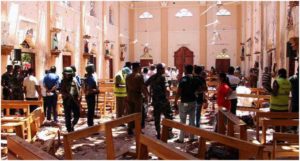
Armed Conflicts, Asia-Pacific, Civil Society, Featured, Global, Global Governance, Headlines, Human Rights, IPS UN: Inside the Glasshouse, Peace, TerraViva United Nations
Tisaranee Gunasekara is a political commentator based in Colombo*
“Unmindful are the walking dead
The known way is an impasse.”
Heraclitus (The Fragments)
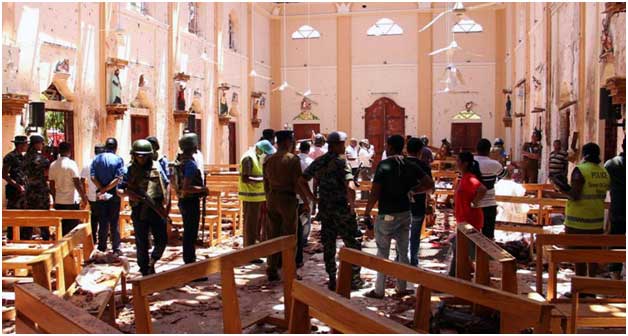
– We have been here before. This blooded precipice is familiar, this looming abyss. What is unfamiliar, what renders the Easter Sunday massacre most vile and truly nightmarish is the total absence of any knowable rationality.
There is no context to this horror, no back-story; it cannot be framed, politically or historically. Other massacres were presaged; this one fell on an unsuspecting people, a killer-bolt on a clear Sunday morning. It is the most heinous and the most incomprehensible act of violence in our violence-ridden history.
Every massacre of innocents leaves behind a heap of questions. The larger why, the philosophical, existential why might be unanswerable, but the smaller whys almost always are.
Whether it was Black July, the Anuradhapura massacre, or any of the civilian bloodletting that came afterwards, there was a discernible path to the outrage paved with a history of real or imagined wrongs.
Not so this massacre of innocents.
That the massacre is the work of an Islamic terror group is now certain, a conclusion made inescapable by the involvement of several suicide bombers. The attacks on the hotels are barbaric, but part of a comprehensible, global pattern. You want to hurt an economy dependent on tourism; you attack places where tourists congregate, from beaches and ancient ruins to hotels.
Not so the targeting of Catholic churches in Sri Lanka. That is where the utter incomprehension stems from. In Sri Lanka, there has been no history of violent animosity between Muslims and Christians/Catholics. Both communities have been targeted by Sinhala-Buddhists on multiple occasions. They were both victims of majoritarian violence, but never responded in kind.
Had the suicide bombers targeted state institutions, places of entertainment, Buddhist temples or even Hindu kovils, it would have made sense in terms of vengeance for a real or imagined wrong.
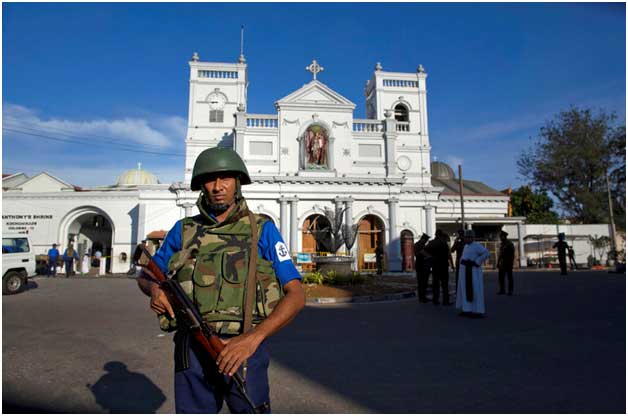
Why churches? Why only Catholic churches?
Churches have been targeted by Islamic terrorists elsewhere in the world, including Asia; the Surabaya bombings in Indonesia and the Jolo church attacks in the Philippines are cases in point. But every one of those attacks could be placed within a national politico-historical context. There is no such context here in Sri Lanka.
Attacks by a lone gunman or a lone bomber might have been comprehensible, the work of a clinically deranged man. But an operation of this complexity and magnitude, involving the willing and knowing cooperation of hundreds of people, is unfathomable.
The killers, the human bombs, are believed to be Lankan Muslim men.
For any terror organisation, suicide killers would be a valuable possession, something you don’t expend in vain. A suicide killer must be trained and groomed right up to the moment of murder, handled with meticulous care, kept on the pre-prepared path, shielded from every human emotion. Why use such valuable and not easily replaceable weapons on targeting a community that had not done you or your local co-religionists any harm?
Were the churches targets of opportunity? In Sri Lanka, churches (along with mosques and kovils) are relatively unprotected and vulnerable. But so are many other institutions and structures, both secular and religious. Was it to gain maximum publicity – bombing churches on Easter Sunday? That would have been a credible explanation had the authors rushed to claim responsibility.
** But so far, no organisation has claimed responsibility, another unusual occurrence. Generally, after a successful operation, the claim to own it is a race. Terrorists love publicity. That is how they gain new recruits and new resources.
So here we are, in a hell both familiar and unfamiliar. How not to plunge from this to a worse hell is the hardest challenge ahead, much harder than identifying, apprehending and punishing the guilty.
An Unforgivable Failure
There is one haunting truth about the Easter Sunday massacre – with a little more vigilance, it might have been prevented. A section of the security establishment seems to have known that an Islamic terror group was planning to target Catholic churches. According to reports, they even knew the names and other details of some of the attackers, possibly ten days ahead.
The speed with which the first arrests were made gives credence to these reports. Such speed by our police can be explained only by prior-knowledge. Greater the speed, greater the prior-knowledge. And the speed was great, unprecedentedly so.
That begs two critical questions.
Who knew? Why did those in the know do nothing with their knowledge?
If the known attackers had been arrested, the massacre wouldn’t have happened. And it could have been done under normal law. The Defence Secretary is lying if he claims that the information was vague and the absence of emergency regulations was a handicap.
If the churches were informed about their peril, they could have taken some precautions. That certainly didn’t require emergency regulations.
With either of those two measures, three hundred innocent lives could have been saved.
We, as a nation, need to know why those lives were wantonly sacrificed. The SLPP had predictably accused the government of not supporting the intelligence agencies, of persecuting and discouraging them. That is incorrect. The intelligence agencies are not the victims of this story. They received the information, and opted not to do anything with it. That was a severe dereliction of duty.
President Maithripala Sirisena must shoulder much of the blame. As the Minister of Defence, protecting the people was his responsibility. He failed abysmally. And he has not apologised for that failure. That doesn’t mean the UNP can exculpate itself from all responsibility, all blame.
The ‘we were not told’ excuse cannot hold water since one of the letters warning about impending terror attacks seems to have been circulating in the social media for days. If Minister Harin Fernando’s father knew about the danger, then the Minister, his cabinet and non-cabinet colleagues and his prime minister cannot plead ignorance.
The government’s failure to stop the massacre fits into a general pattern of indifference towards all forms of extremism. One week before the Easter Sunday massacre, on Palm Sunday, a Methodist church in Anuradhapura was attacked, reportedly by a Sinhala-Buddhist mob. The police refused either to apprehend the attackers or to protect the victims. The government didn’t condemn the attack, didn’t order the police to catch the culprits. All it did was to promise the church protection for Easter.
The promise reportedly came from the Prime Minister. There was not a hum from the President. Political leaders on all sides of the divide, including the minister in charge of Christian Affairs, acted blind, deaf, and mute.
Perhaps this blasé attitude of the political class percolated to the intelligence establishment. Perhaps those in the know thought that there was no need to act if the intended target was a church, or some other minority religious establishment. After all, thirteen months have passed since the anti-Muslim riots of Digana. Time enough for the main suspects to be tried in a court of law. Yet no one has been formally charged and every suspect is out on bail.
Had the government honoured its promise to end impunity and ensure justice, had it honoured the promise to combat extremism and promote moderation, the Easter Sunday massacre might have been avoided. This government did not promote extremism, like its predecessor. But it didn’t resist extremism either. It turned itself into a bystander. Three hundred innocent people paid for that cowardice, that indifference, with their lives.
The next vicious spiral
A new fault line has been created in Sri Lanka’s already seriously compromised societal fabric. A new enmity has been birthed. This is not the moment for anodyne slogans about unity and peace. The peril cannot be resisted, if its existence is unacknowledged.
Sri Lanka’s blood-soaked history provides us with ample warning of the dangers ahead.
Will the targeting of Catholics by Islamic terrorists create an endless blood feud between Lankan Catholics and Lankan Muslims? Will the wronged Catholics themselves do wrong by targeting innocent Muslims?
The fear that the Easter Sunday massacre will lead to a round of attacks on Muslim properties and religious establishments has so far not materialised. For this, the government, especially the UNP, deserves the credit. When the first attack on a mosque was reported, immediate action was taken, including the imposition of a curfew. That probably saved the country from another round of bloodletting. But the danger will not be over in a day, or even a year. Only constant vigilance can prevent another tragedy.
Terrorists of all kinds have two targets – one the purported enemy; the other, one’s own community. The authors of the Easter Sunday’s massacre of innocents would have known that they were placing their own innocent coreligionists in peril. They would have known that retaliatory attacks could happen, if not in the immediate aftermath, then someday.
And they wouldn’t have cared. That is a function of extremism. They not only hate their enemies. They don’t care about their own community. The cancer of extremism that is affecting Lankan religions must be combated, perhaps primarily from within.
The first step is to start criticising one’s own extremists. It is only by taking an unequivocal stand against extremists of our own community do we earn the moral right to criticise extremists of other communities.
Sinhalese and Tamils failed to take a stand against their own extremists; each community raged against the other’s tribalism while justifying one’s own. That failure caused both communities incalculable harm, and incalculable self-harm. Black July turned a marginal insurgency into a full scale war. The LTTE’s countless atrocities eventually contributed to its own shameful defeat.
When Sinhala-Buddhists attacked Muslims in Digana in the name of Buddhism, the absolute majority of Buddhist leaders remained mute. The Muslim leaders will hopefully set a different example, not just in the immediate aftermath, but continuously. The task would be long and hard.
Though Lankan Muslims have been the victims of both Sinhala-Buddhist and LTTE violence, the atrocities committed by Muslims elsewhere in the world have rebounded on them unjustly, enveloping them in a miasma of fear and suspicion. Easter Sunday’s massacre will worsen their plight.
There is a danger of Muslims being considered as enemies by all other communities. Extremists within the Sinhala-Buddhist fold will work towards such an outcome. One can almost hear the likes of Galagoda-Atte Gnanasara crowing. Forgotten will be the role played by anti-Muslim violence in fostering Muslim extremism.
But that too would be in accordance with the intent of the attackers. As Moroccan editor Ahmed Benchemsi opined, “…..spreading hate is the terrorists’ job. Hating you is not enough; they also need you to hate them, so the struggle goes unchallenged” (Newsweek – 20.11.2008).
Terrorists revel in hate, and they want that hate to be extended to their racial/religious community as well. They want their crime to become the crime of their entire community, falling even unto unborn children. When such hatred seeps into a national bloodstream, the terrorists achieve their final victory. That happened between Sinhalese and Tamils. It mustn’t happen between Lankan Catholics and Lankan Muslims.
Sadly, hate is easy to cultivate. It can flourish anywhere. All it needs is an inch, a second, a thought, a glance, one unguarded moment. And a destructive atom can always survive, waiting with endless patience until the next time.
So, we stand on a familiar precipice, staring at a familiar abyss. This time, the task of guiding us away from it, towards the plains of moderation and stability belongs to Muslims and Catholics. This is their moment to be what Sinhalese and Tamils were not at comparable moments in their histories.
This is their moment to place their humanity above every other consideration, in a way we, Sinhalese and Tamils, failed to. And it is for us, especially Sinhala-Buddhists, to prevent our own extremists from intervening to sow hate, to prevent healing, to peddle vengeance in the guise of justice.
As Aristotle said, “For the things we have to learn before we do them, we learn by doing them… We become just by just acts, temperate by doing temperate acts…” (Necomachean Ethics). In this moment, grand gestures are necessary; but every little act of ordinary decency and kindness counts. If our leaders, elected and self-appointed, fail to stand against extremism, fail to build an alliance of moderates, perhaps we, the people, who are outraged by Easter Sunday’s massacre of innocents can.
*This analysis was written on April 23, two days following the Easter Sunday terrorist attacks in Sri Lanka.
** Since then, there have been reports that ISIS has claimed responsibility for inspiring the attacks.